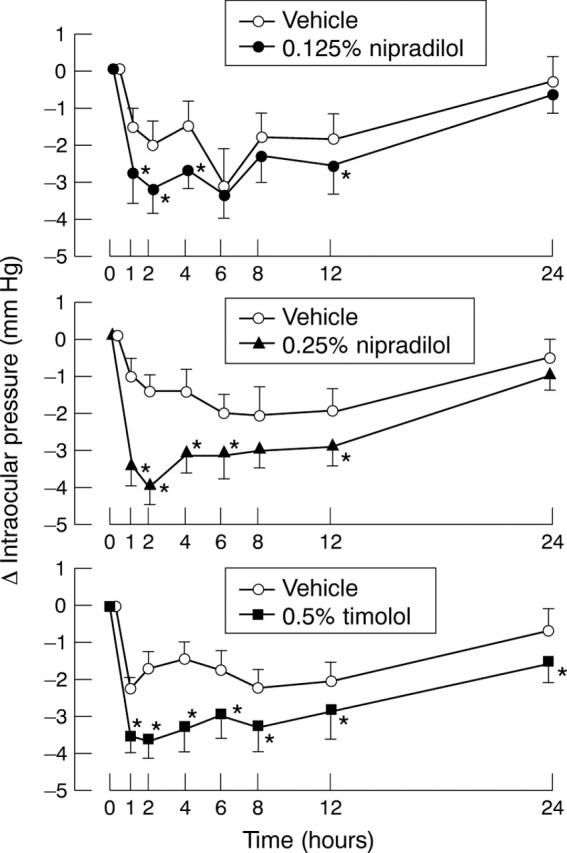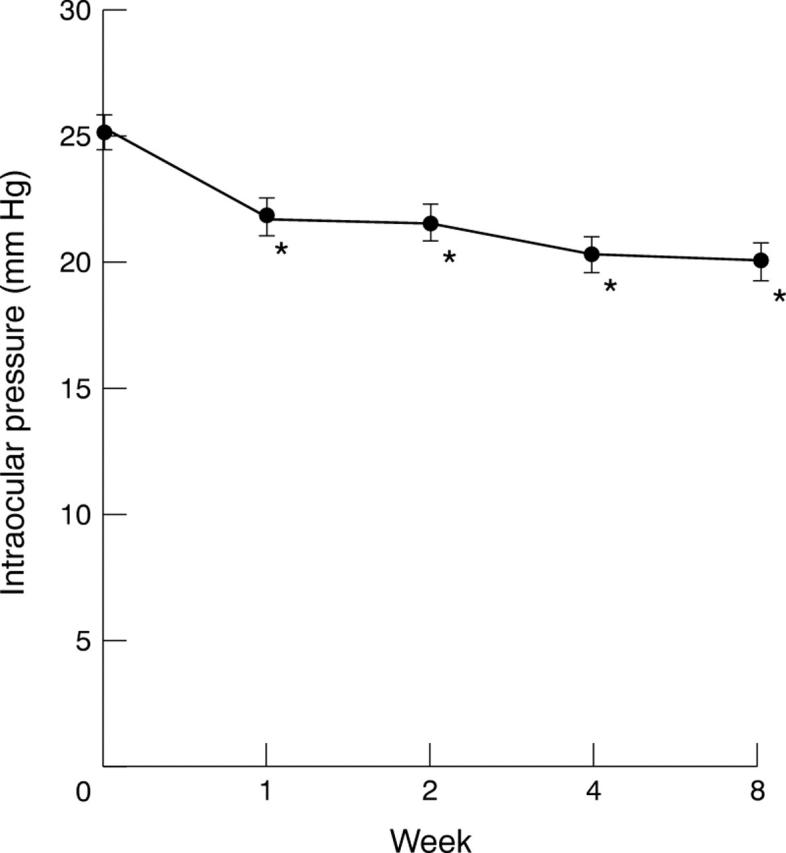Abstract
AIMS—To study the effects of topical nipradilol, a non-selective β blocker with α blocking and nitroglycerin-like activities, on intraocular pressure (IOP) and aqueous humour dynamics in normal humans and in patients with ocular hypertension. METHODS—Nipradilol (0.06%, 0.125%, 0.25%, 0.5%) was applied to normal volunteers (n = 12) to test for IOP lowering effects. In a second group of normal volunteers (n = 11), nipradilol (0.125% and 0.25%) and timolol (0.5%) were compared for IOP lowering effects. After a single administration of 0.25% nipradilol, IOP, flare intensity in the anterior chamber, aqueous flow, uveoscleral outflow, tonographic outflow facility, and episcleral venous pressure were either directly measured or mathematically calculated. Topical nipradilol (0.25%) was administered to 24 patients with ocular hypertension twice daily for 8 weeks. RESULTS—Administration of 0.25% nipradilol decreased IOP with a maximum reduction of 4.2 mm Hg lasting 12 hours. A single instillation of both 0.25% nipradilol and 0.5% timolol reduced the IOP in normotensive human subjects to the same degree. A single instillation of 0.25% nipradilol decreased the aqueous flow rate in the treated eye by 20%. Nipradilol produced no significant effect in tonographic outflow facility or episcleral venous pressure, but uveoscleral outflow was increased. In patients with ocular hypertension, twice daily instillation of 0.25% nipradilol decreased IOP without tachyphylaxis for the 8 week test period. CONCLUSION—Topical nipradilol (0.25%) reduced IOP by decreasing the aqueous flow rate and probably also by increasing uveoscleral outflow. Nipradilol should be further investigated as a new antiglaucoma drug.
Full Text
The Full Text of this article is available as a PDF (162.7 KB).
Figure 1 .

Reduction in the intraocular pressure after 0.125%, 0.25% nipradilol, or 0.5% timolol instillation in drug treated eye and vehicle treated eye. Δ Intraocular pressure = difference between the change from pretreatment values in the drug treated experiment (0.125% or 0.25% nipradilol or 0.5% timolol solution instilled in one eye and vehicle in fellow eye) and that in the control experiment (vehicle solutions instilled in both eyes). Figures are significantly negative, *p<0.05. Bars represent mean (SE) (mm Hg) in 11 eyes of 11 subjects.
Figure 2 .

Intraocular pressure after twice daily instillation of 0.25% nipradilol during 8 weeks. Bars represent mean (SE) (mm Hg) in 24 eyes of 24 subjects. *Compared with week 0, v week 1; p=0.0016, v week 2; p=0.0022, v week 3; p<0.0001, v week 4; p<0.0001 (paired t test with Bonferroni's correction).
Selected References
These references are in PubMed. This may not be the complete list of references from this article.
- Hayashi M., Yablonski M. E., Novack G. D. Trabecular outflow facility determined by fluorophotometry in human subjects. Exp Eye Res. 1989 May;48(5):621–625. doi: 10.1016/0014-4835(89)90004-3. [DOI] [PubMed] [Google Scholar]
- Jones R. F., Maurice D. M. New methods of measuring the rate of aqueous flow in man with fluorescein. Exp Eye Res. 1966 Jul;5(3):208–220. doi: 10.1016/s0014-4835(66)80009-x. [DOI] [PubMed] [Google Scholar]
- Kanno M., Araie M., Tomita K., Sawanobori K. Effects of topical nipradilol, a beta-blocking agent with alpha-blocking and nitroglycerin-like activities, on aqueous humor dynamics and fundus circulation. Invest Ophthalmol Vis Sci. 1998 Apr;39(5):736–743. [PubMed] [Google Scholar]
- Krupin T., Feitl M., Becker B. Effect of prazosin on aqueous humor dynamics in rabbits. Arch Ophthalmol. 1980 Sep;98(9):1639–1642. doi: 10.1001/archopht.1980.01020040491021. [DOI] [PubMed] [Google Scholar]
- Lam A. K., Douthwaite W. A. A pilot study on the measurement of central posterior corneal radius in Hong Kong Chinese using Purkinje image technique. Ophthalmic Physiol Opt. 1997 Jan;17(1):68–74. [PubMed] [Google Scholar]
- Mori M., Araie M. A simple method of determining the time course of timolol's effects on aqueous flow in humans. Arch Ophthalmol. 1991 Aug;109(8):1099–1103. doi: 10.1001/archopht.1991.01080080059028. [DOI] [PubMed] [Google Scholar]
- Nathanson J. A. Nitrovasodilators as a new class of ocular hypotensive agents. J Pharmacol Exp Ther. 1992 Mar;260(3):956–965. [PubMed] [Google Scholar]
- Ohira A., Wada Y., Fujii M., Nakamura M., Kasuya Y., Hamada Y., Shigenobu K. Effects of nipradilol (K-351) on alpha-adrenoceptor mediated responses in various isolated tissues. Arch Int Pharmacodyn Ther. 1985 Nov;278(1):61–71. [PubMed] [Google Scholar]
- Oshika T., Araie M., Sugiyama T., Nakajima M., Azuma I. Effect of bunazosin hydrochloride on intraocular pressure and aqueous humor dynamics in normotensive human eyes. Arch Ophthalmol. 1991 Nov;109(11):1569–1574. doi: 10.1001/archopht.1991.01080110105046. [DOI] [PubMed] [Google Scholar]
- Oshika T., Araie M. Time course of changes in aqueous protein concentration and flow rate after oral acetazolamide. Invest Ophthalmol Vis Sci. 1990 Mar 1;31(3):527–534. [PubMed] [Google Scholar]
- Sakurai M., Araie M., Oshika T., Mori M., Masuda K., Ueno R., Takase M. Effects of topical application of UF-021, a novel prostaglandin derivative, on aqueous humor dynamics in normal human eyes. Jpn J Ophthalmol. 1991;35(2):156–165. [PubMed] [Google Scholar]
- Schuman J. S., Erickson K., Nathanson J. A. Nitrovasodilator effects on intraocular pressure and outflow facility in monkeys. Exp Eye Res. 1994 Jan;58(1):99–105. doi: 10.1006/exer.1994.1199. [DOI] [PubMed] [Google Scholar]
- Scriabine A., Torchiana M. L., Stavorski J. M., Ludden C. T., Minsker D. H., Stone C. A. Some cardiovascular effects of timolol a new beta-adrenergic blocking agent. Arch Int Pharmacodyn Ther. 1973 Sep;205(1):76–93. [PubMed] [Google Scholar]
- Serle J. B., Stein A. J., Podos S. M., Severin C. H. Corynanthine and aqueous humor dynamics in rabbits and monkeys. Arch Ophthalmol. 1984 Sep;102(9):1385–1388. doi: 10.1001/archopht.1984.01040031127039. [DOI] [PubMed] [Google Scholar]
- Shirasawa Y., Fujii M., Nakamura M. Venodilating action of nipradilol (K-351) in the pithed rat pretreated with dihydroergotamine. Jpn J Pharmacol. 1985 Sep;39(1):77–82. doi: 10.1254/jjp.39.77. [DOI] [PubMed] [Google Scholar]
- Smith B. R., Murray D. L., Leopold I. H. Influence of topically applied prazosin on the intraocular pressure of experimental animals. Arch Ophthalmol. 1979 Oct;97(10):1933–1936. doi: 10.1001/archopht.1979.01020020381023. [DOI] [PubMed] [Google Scholar]
- Taniguchi T., Deguchi T., Ogawa T., Kitazawa Y. [Effects of amosulalol hydrochloride on intraocular pressure and aqueous humor dynamics in the rabbit eye]. Nippon Ganka Gakkai Zasshi. 1996 Apr;100(4):279–283. [PubMed] [Google Scholar]
- Tomlinson A., Leighton D. A. Ocular dimensions and the heredity of open-angle glaucoma. Br J Ophthalmol. 1974 Jan;58(1):68–74. doi: 10.1136/bjo.58.1.68. [DOI] [PMC free article] [PubMed] [Google Scholar]
- Uchida Y., Nakamura M., Shimizu S., Shirasawa Y., Fujii M. Vasoactive and beta-adrenoceptor blocking properties of 3,4-dihydro-8-(2-hydroxy-3-isopropylamino) propoxy-3-nitroxy-2H-1-benzopyran (K-351), a new antihypertensive agent. Arch Int Pharmacodyn Ther. 1983 Mar;262(1):132–149. [PubMed] [Google Scholar]
- Zimmerman T. J., Kooner K. S., Kandarakis A. S., Ziegler L. P. Improving the therapeutic index of topically applied ocular drugs. Arch Ophthalmol. 1984 Apr;102(4):551–553. doi: 10.1001/archopht.1984.01040030429017. [DOI] [PubMed] [Google Scholar]


